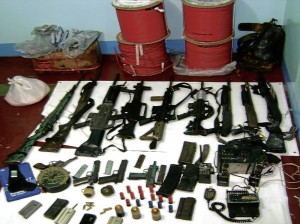Half a ton of cyanide seized in raid in Zamboanga del Sur

Aside from half a ton of cyanide, police also seized assault rifles, detonating cords, ammunition and two-way radio sets during a raid on a hut owned by a councilor linked to the operations of illegal mining in Bayog, Zamboanga del Sur. JULIE ALIPALA/INQUIRER MINDANAO
ZAMBOANGA CITY—Half a ton of cyanide, a highly toxic substance, had been seized by police during a recent raid on what authorities said were illegal mining operations in Zamboanga del Sur.
Senior Superintendent Edgar Danao, head of the police’s Criminal Investigation and Detection Group (CIDG) in Western Mindanao, said law enforcers found the cyanide stock during a raid on October 12 on a hut owned by Julieto Monding.
Monding, a councilor in one of the towns of Zamboanga del Sur, is reported to head the Monte de Oro Small-Scale Miners’ Association (Mossma), a group of small-scale mining operators that recently lost a bid in the provincial government to have the area that it is operating in declared as a “Minahang Bayan.”
Illegal mines
Mossma is operating in areas in Bayog, Zamboanga del Sur, that are covered by a mineral production sharing agreement (MPSA) that has been granted to an affiliate of one of the biggest mining firms in the world, TVI Resources Phils. Inc. (TVIRD).
Article continues after this advertisementUnder the executive order recently issued by President Aquino on mining, no mining operations are to be allowed in areas already covered by MPSA, a contract between a mining firm and government to develop mines.
Article continues after this advertisementDanao said the raid, conducted on the hut owned by Monding in Sitio (settlement) Depore, also yielded a sack of borax, 45 sacks of limestone and other toxic substances, like nitric acid.
Borax, according to the online encyclopedia Wikipedia, often comes in the form of white powder that is used in small-scale mining. Prolonged exposure to it, said the website, can cause respiratory and skin irritation.
Small doses
The kind of cyanide used in mining is a highly toxic and regulated substance in the Philippines.
Medical journals said that ingestion of a small quantity of solid cyanide, or cyanide solution, would cause death within minutes. As little as 200 milligrams of cyanide solution is highly lethal.
Danao said aside from the haul of toxic chemicals, 10 men were also arrested during the raid. Some of those arrested yielded firearms and explosives, he said.
At the hut where the toxic substances were found, Danao said the raiding team also found detonating cords for dynamite.
Charges of violation of Republic Act No. 6969 (the Toxic Substances, Hazardous and Nuclear Waste Control Act) were being prepared against the suspects. They would also be charged with illegal possession of firearms and explosives, Danao said.
Monding was not around during the raid, however.
Death by poisoning
Cyanide can be a colorless gas, such as hydrogen cyanide or cyanogen chloride, or in crystal form, such as sodium cyanide or potassium cyanide.
People exposed to a small amount of cyanide may experience rapid breathing, restlessness, dizziness, weakness, headache, nausea and vomiting and rapid heart rate.
Meanwhile, exposure to large amounts of cyanide may cause convulsions, low blood pressure, slow heart rate, loss of consciousness, lung injury and respiratory failure which leads to death.
Survivors of serious cyanide poisoning may develop heart and brain damage.—Julie Alipala with Inquirer Research